Is Etsy legit? 9 Etsy scams to avoid
Etsy is a legitimate platform, but not every Etsy buyer or seller has good intentions. Learn how to spot common Etsy scams, avoid fraud, and shop more safely. Plus, see how Norton 360 Deluxe’s AI-powered scam-busting assistant can help protect you from sophisticated online threats.

Key takeaways
- Etsy is a legitimate platform, but scams can still occur.
- Etsy scams include off-platform payment requests, counterfeit items, and phishing messages impersonating real Etsy communications.
- Shop more safely on Etsy by paying on-platform only, protecting your account with 2FA, and performing a reverse image search on listing photos.
Etsy is a legitimate and generally safe online marketplace for handmade and vintage items. With around 96 million active buyers across Etsy marketplaces, it’s a legitimate company that is mostly safe to order from. But, like any online platform, it’s not immune to scams.
To help you shop safely, we’ve outlined nine common Etsy scams and how to avoid them. Keep reading to stay informed and protect yourself while browsing for unique finds.
Is Etsy safe?
Etsy is considered a safe and trustworthy platform for shopping. However, like other online marketplaces such as Poshmark and eBay, it can attract scammers.
One California woman fell victim to an Etsy scam after talking with fake Etsy customer support representatives and lost her entire life savings. Another Etsy shopper spent $95 on an item that never arrived. While these stories are alarming, they don’t represent the experience of most Etsy shoppers.
You can help avoid Etsy scams by following online shopping safety precautions and using Etsy’s built-in security features.
Etsy safety features
To help protect buyers, Etsy offers several safety features.
- Etsy payments: Etsy’s secure payment system processes transactions using encryption, helping to prevent fraud and unauthorized charges.
- Etsy purchase protection: Etsy issues refunds through its Purchase Protection Program that covers items that don’t arrive or aren’t as described.
- Two-factor authentication: Two-factor authentication (2FA) adds an extra layer of security by requiring a second verification step when signing in, making it harder for hackers to access your Etsy account.
- Sign-in notifications: Etsy sends alerts whenever someone logs into your account from a new device, potentially notifying you of suspicious activity.
- Sign-in history: You can check your account’s sign-in history to spot any unusual activity and help your account stay secure.
9 Etsy scams to watch out for
Although Etsy is typically a safe platform, not everyone on Etsy has integrity. Scammers may attempt to sell fake products, request off-platform payments, or even hack into accounts. Luckily, there are telltale signs that can help you spot an Etsy scammer.
Here are scams you should watch out for on the platform and tips to avoid falling for them.
1. Fake or counterfeit products
In this internet scam, an Etsy scammer advertises a product that’s of a much higher quality than what they end up shipping to you. Instead of getting the high-quality designer product you ordered, you get a cheaper, sometimes fake, product. To make this scam believable, some scammers use images stolen from genuine manufacturers.
For example, you might see a listing for a “handmade designer bag” sold at a fraction of the average retail price. When the bag arrives, it’s clearly a counterfeit, made of inferior materials, or lacking the craftsmanship advertised.
2. Wrong address scams
In a wrong address scam, the seller intentionally ships your item to an incorrect address, usually one they own or control. When you don’t receive your item and raise a claim, the scammer provides proof of shipping to Etsy, complicating your refund process. Some scammers may even use stolen or fake tracking numbers to “prove” that an item was delivered.
3. Off-platform payment requests
In this scam, cybercriminals claim there’s a technical issue preventing you from purchasing through Etsy, or try to entice you with a discount or faster shipping if you pay via apps like Venmo or PayPal. Others may request cryptocurrency or a wire transfer, and some may even try to scam you out of gift cards.
But after you pay, they never ship the item, possibly close the shop, and you won’t have any way of getting a refund, since Etsy only covers transactions made on the platform.
4. Inconsistent pricing
Some Etsy sellers offer the same item at different prices across multiple shops and platforms to game Etsy’s algorithm — the cheaper version usually ranks higher in search results. But if you try to buy the lower-priced item, the dishonest seller might claim it’s out of stock and direct you to a more expensive listing instead.
This tactic misleads shoppers and takes advantage of Etsy’s ranking system to drive sales at higher prices.
5. Bait-and-switch scams
Bait-and-switch scams on Etsy involve sellers advertising one product, then sending something completely different — usually of lower quality. In many cases, the item you receive is a cheap, mass-produced product that’s sold elsewhere for a fraction of the price. Scammers often list these items on Etsy as “handmade” or “unique” to justify a high markup and mislead buyers.
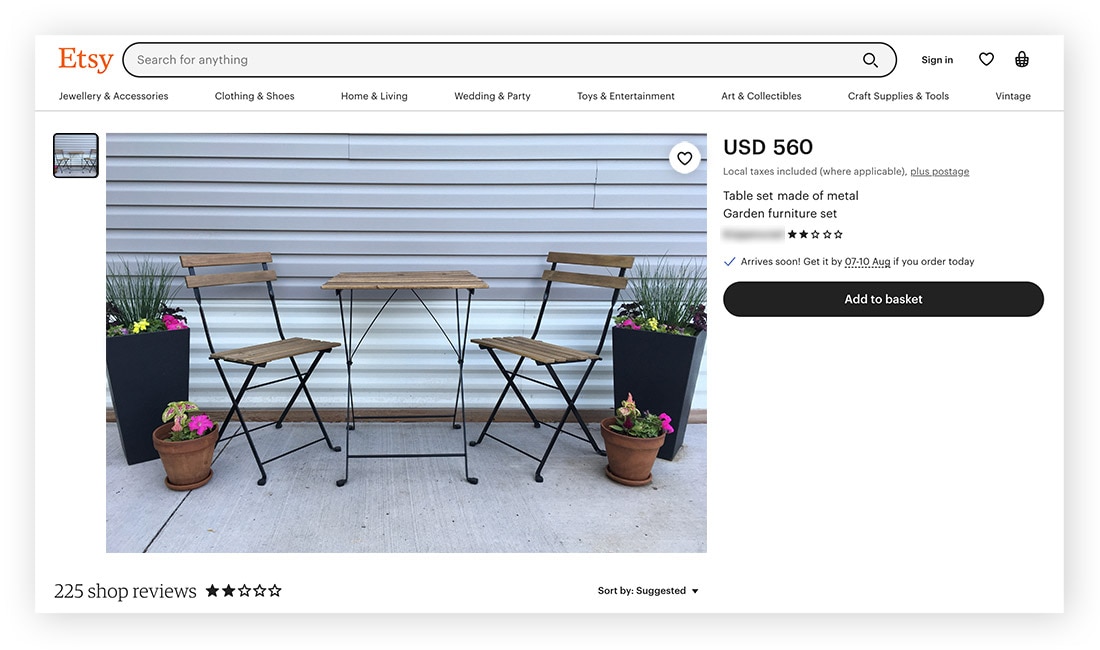

One Washington Post writer ordered a cherry-themed necklace from Etsy, expecting a high-quality piece. Instead, she received a broken, cheaply made plastic version. When she checked the return address, she discovered it was from JFK Airport — confirming she had fallen for a dropshipping bait-and-switch scam, and the shop had vanished.
6. Fake Etsy shops
In more serious cases, scammers set up entire fake Etsy shops to trick buyers into handing over money for non-existent or misrepresented products. These shops often disappear quickly — sometimes before you even realize you’ve been scammed.
Even if you’re able to halt the payment via your bank, scammers could still end up with some of your personal information, like your name, email address, and shipping info. This could lead to further fraud, phishing attacks, or even identity theft.
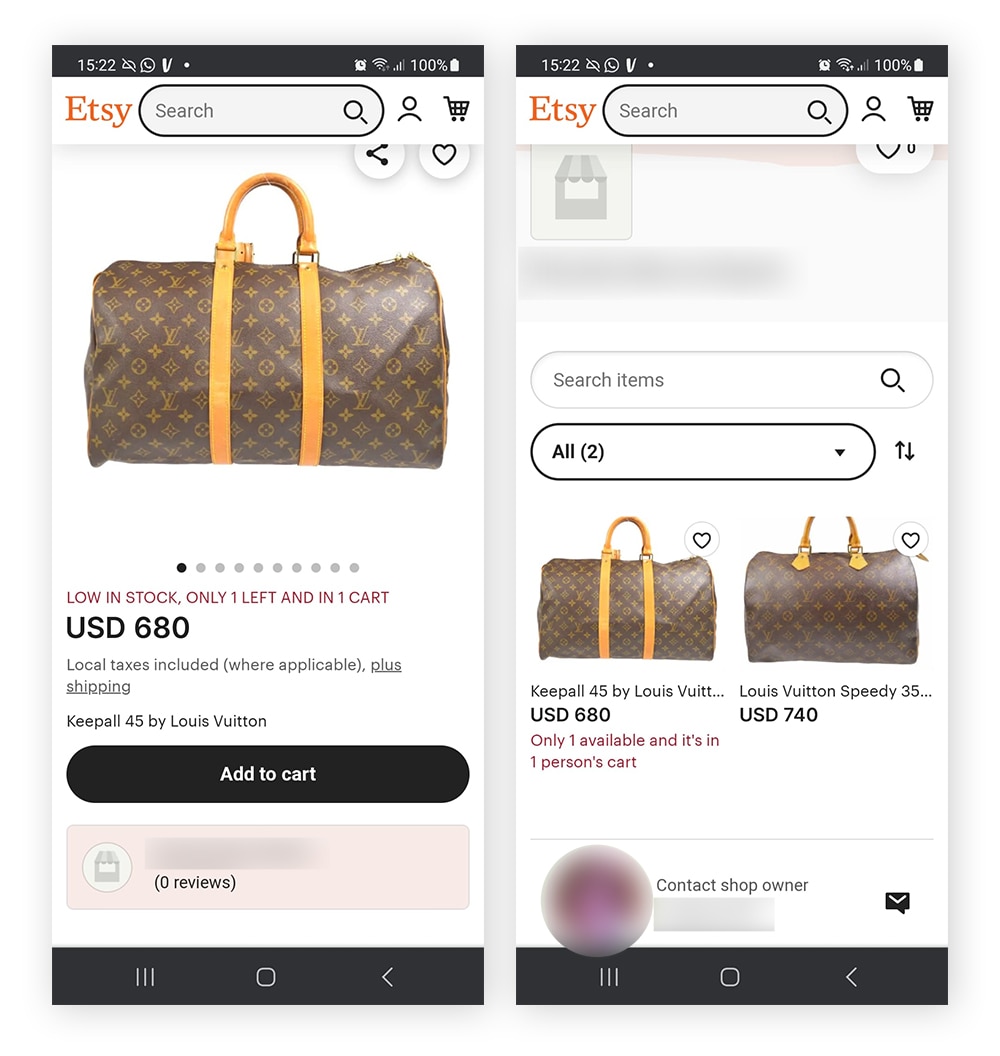

To protect yourself, it’s important to know how to spot a fake Etsy shop. Watch for these red flags:
- Poor spelling and grammar: Most legitimate sellers take the time to create professional, error-free listings.
- No sales or reviews: Stores with few reviews and no sales history are a possible red flag that you’re dealing with a scammer.
- Stolen product images: Some Etsy scammers steal product images from legitimate Etsy shops or other online retailers. Perform a reverse image search to see if the photo used in the listing is from a different online retailer.
- Negative reviews: Notice many negative reviews for an Etsy shop? This likely means a scammer runs the shop, and you should look for a more reputable seller.
7. Links to malicious websites
Some scammers on Etsy entice customers to external websites with the promise of lower prices. Once you leave Etsy, you may end up on a malicious website designed to infect your device with malware or steal your personal information. In the worst-case scenario, these sites may help hackers access your device.
8. Phishing
In some types of phishing attacks, scammers impersonate Etsy representatives to trick you into revealing personal or financial information. They use deceptive messages to pressure you into clicking malicious links, entering your login credentials, or sharing bank details.
These scammers often claim that urgent action is needed for account verification or security checks. They usually go to great lengths to make their requests seem legitimate. Their ultimate goal is to steal your information, gain unauthorized access to your accounts, or swindle you out of money.
One Reddit user nearly fell for an Etsy phishing scam after receiving a text message claiming their account had been suspended due to a payment issue. The message contained a link leading to a spoofed Etsy page that looked convincing and even redirected searches to Etsy’s real site. Etsy support later confirmed it was a scam.
9. Etsy account takeovers
If you fall for a phishing attack or your login credentials are stolen, hackers could gain access to your Etsy account and take it over. To achieve this, scammers use various techniques, including smishing and malware, which allow them to steal personal information and gain access to your accounts.
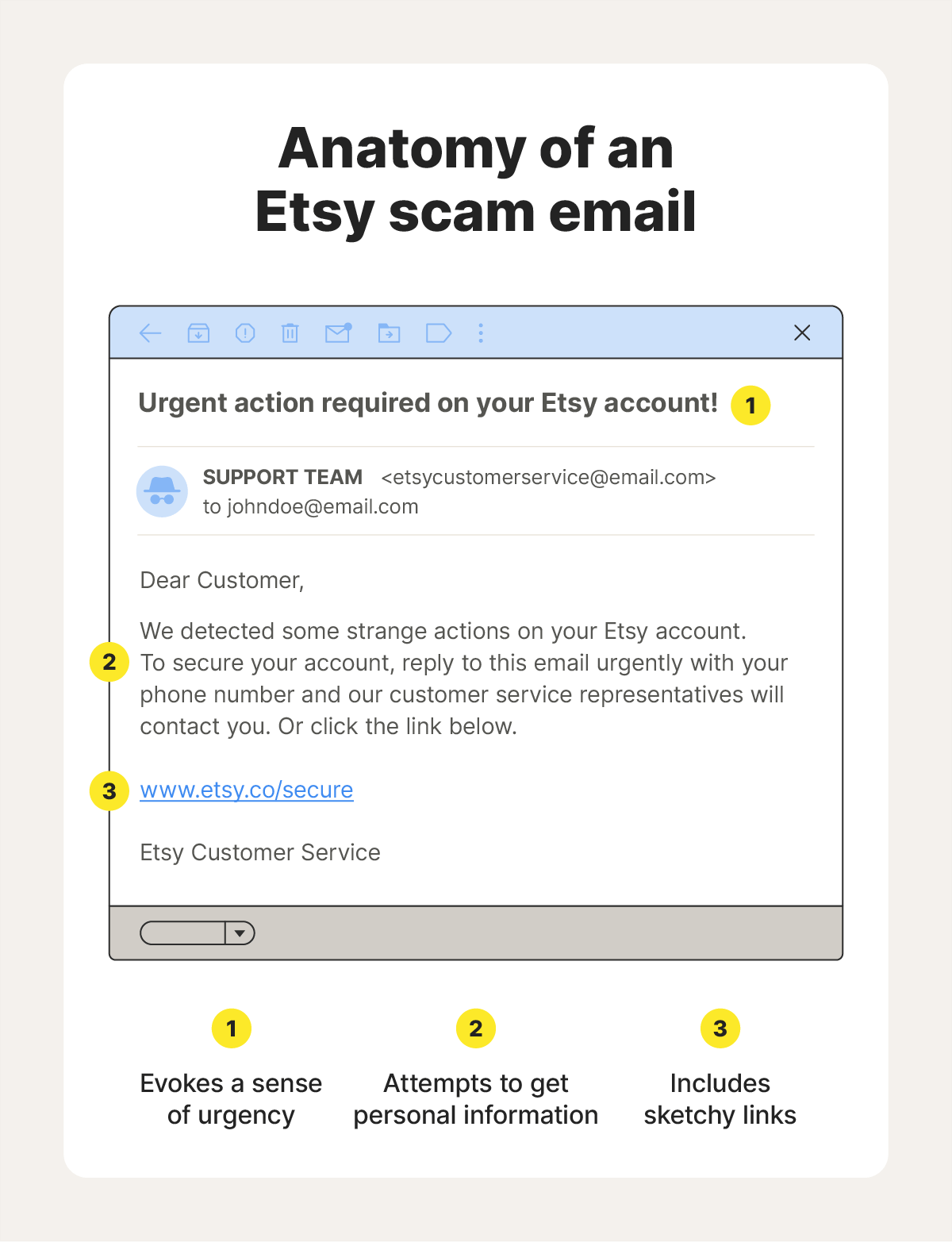

For example, you may receive a phishing email claiming it’s from Etsy customer service. The email is carefully crafted to deceive you into revealing your login credentials, giving the scammer unauthorized access to your account.
How to spot an Etsy scam
Warning signs of Etsy scams include seller profiles riddled with grammar mistakes, requests for payments outside the platform, and bad or inauthentic-seeming reviews.
Here’s how to tell if an Etsy seller is legit or not:
Unprofessional profile
Legitimate sellers typically have a complete Etsy profile with details about themselves and their business. A profile full of spelling and grammatical errors that lacks detailed information or uses generic stock images could be an Etsy scammer.
Little to no sales history
Etsy scammers often create new profiles to avoid bad reviews from previous scam victims. Before making a purchase, check if the seller has a history of sales and reviews from other customers. While not all new sellers are scammers, shop cautiously when buying from someone without prior sales or feedback — it could be a fake account.
Requests for off-platform payment
Beware of sellers who insist on making transactions outside of Etsy’s secure payment platform by asking for payment over P2P apps, cryptocurrency, or wire transfers. It’s almost certainly a scam, and they’re likely trying to evade the platform’s protections.
Bad reviews
A pattern of bad reviews could signal that the seller is unreliable — or running a scam. But it’s not just negative feedback to look out for. Also watch for suspicious positive review patterns. For example, a sudden flood of generic, overly positive reviews in a short period may suggest the seller is trying to fake credibility.
Stolen product pictures
If the product images look overly professional, generic, or are inconsistent with other items in the shop, perform a reverse image search to see if they appear elsewhere on the internet. If they do — it’s likely a scam.
Long wait times and costly shipping methods
Unusually long delivery times or exorbitant shipping costs with no explanation can be a red flag. Some Etsy scammers use these tactics to buy time or extract more money from buyers.
Typically, Etsy orders arrive within a few days to a few weeks, depending on the seller’s location and shipping method. Shipping costs generally range from $3 to $10 for small items and can go up to $20 or more for larger or international orders.
Evasive communication
Etsy allows you to message a seller before you make a purchase. A trustworthy Etsy seller usually responds politely, clearly, and professionally — even if they don’t answer right away. If a seller avoids answering basic questions, gives vague or inconsistent information, or pressures you to buy quickly, it could be a sign they’re a scammer.
Links to external websites
Avoid shopping from sellers who direct you to an external website to complete a transaction. Aside from falling victim to Etsy fraud, visiting unsafe websites can compromise your security and privacy in other ways. These sites may install malware, steal your payment information, or phish for personal data.
Too-good-to-be-true pricing
Genuine luxury or high-quality handmade items typically come at a higher price point than mass-produced items. Extreme discounts can indicate the item is a counterfeit or scam. Trust your instincts. If a price seems too good to be true, it probably is.
Requests for personal information
An Etsy scammer may use a pending transaction as an excuse to ask you for personal information, hoping you’ll give it to them without thinking twice. To help protect yourself against identity theft, don’t share sensitive personal information with an Etsy seller — or any stranger on the internet.
To help protect your personal information from scammers on Etsy, get Norton 360 Deluxe. It helps block fake websites designed to steal your passwords, defends against malware that could compromise your devices, and comes with Scam Protection.
How to protect yourself from Etsy scams
Sticking to safe online shopping practices can help reduce your risk of getting scammed. Here are some key ways to help protect yourself against Etsy scams.
- Use strong passwords. Always use a complex and unique password for your Etsy account.
- Research the seller before purchasing. Check out their sales history, reviews, and ratings. If anything feels off, look for a more reliable seller.
- Use a VPN. Use a VPN while shopping on public Wi-Fi to help stop hackers from intercepting your login credentials.
- Perform a reverse image search. If a product looks too good to be true, do a quick reverse image search to see if it’s sold elsewhere.
- Only pay on Etsy. Don’t pay for Etsy items outside of the platform.
- Enable multi-factor authentication. Enabling 2FA on your online accounts adds extra security. Even if a hacker manages to get your password, they would still need access to a second form of verification, such as a code sent to your phone, making it much harder for them to access your account.
- Use AI-powered scam detection. Using a tool like Norton Genie, an AI-powered assistant, can help you determine if a message is a concealed phishing attack — just upload a screenshot or URL for guidance. It also comes as part of Norton 360 Deluxe to give you antivirus and scam protection in one.
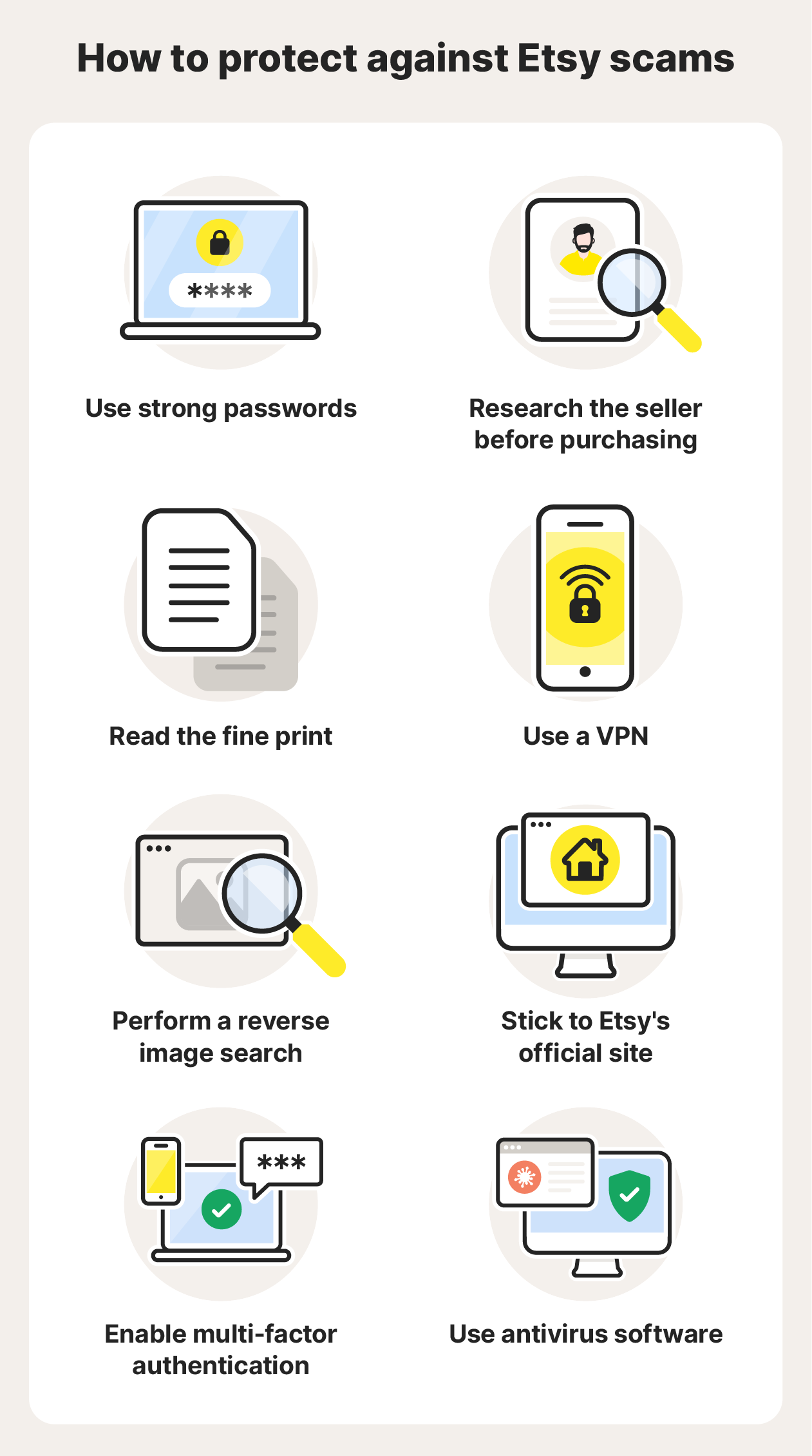

What to do if you’re scammed on Etsy
If you suspect you were scammed on Etsy, follow this step-by-step guide to protect yourself and your personal information.
- Request a refund. First, request a refund from the seller. If they don’t respond within 48 hours, open a case with Etsy.
- Report the scam to Etsy. Report a specific item or an entire shop using the instructions in the Etsy Help Center.
- File a chargeback for your payment card. If your refund request and report to Etsy don’t solve the problem, contact your bank or credit card company to dispute the charge.
- Change your Etsy password. Change your Etsy password quickly to protect your account. This is particularly important in a suspected identity theft or account hacking incident.
- Freeze your credit. If you suspect your personal information was stolen, consider freezing your credit. This helps stop scammers from opening lines of credit in your name.
- Report the scam to the Federal Trade Commission (FTC). The FTC tracks and investigates scam complaints. Report the scam via the FTC website, and you’ll get additional advice from them.
- Monitor your financial statements. Keep a close eye on your bank and credit card statements. If you spot any unusual activity, contact your financial institution immediately.
Shop online with peace of mind
Etsy does its best to protect shoppers, but fraudsters and scammers are constantly coming up with ways to evade safeguards and trick you out of your personal information or money.
With powerful AI scam-detection tools, Norton 360 Deluxe can help protect you from scammy links and phishing attacks — as well as viruses, malware, and other insidious online threats. Additionally, our built-in VPN encrypts your connection to keep the personal and financial information you send and receive private, so you can shop in peace.
FAQs
How can you tell if an Etsy seller is legit?
A legit Etsy seller has a history of sales, positive reviews, clear product descriptions, and transparent policies. They communicate professionally and never ask for off-platform payments or personal information. If a listing seems vague or suspicious, it’s best to leave it alone.
Will Etsy refund money if scammed?
Etsy offers Purchase Protection for eligible orders. However, this protection only applies to transactions made directly through Etsy. If you pay outside the platform, Etsy won’t cover your purchase, leaving you at risk of losing your money.
What happens if you don’t receive an Etsy order?
If your order never arrives, you should first report the issue to the seller. You can file a case with Etsy if they don’t respond appropriately. Always keep communication and transactions within the Etsy platform to ensure their protection policies cover you.
Is Etsy safe to sell on?
Etsy is mostly safe for sellers, but scams can still happen. To help, Etsy’s Purchase Protection Program for Sellers covers eligible orders up to $250 (including shipping and taxes) if an item is lost, arrives late, or if there’s a dispute over listing accuracy. Sellers must use Etsy Payments, ship on time with valid tracking, and follow Etsy’s policies to qualify.
Etsy is a trademark of Etsy, Inc.
Editorial note: Our articles provide educational information for you. Our offerings may not cover or protect against every type of crime, fraud, or threat we write about. Our goal is to increase awareness about Cyber Safety. Please review complete Terms during enrollment or setup. Remember that no one can prevent all identity theft or cybercrime, and that LifeLock does not monitor all transactions at all businesses. The Norton and LifeLock brands are part of Gen Digital Inc.




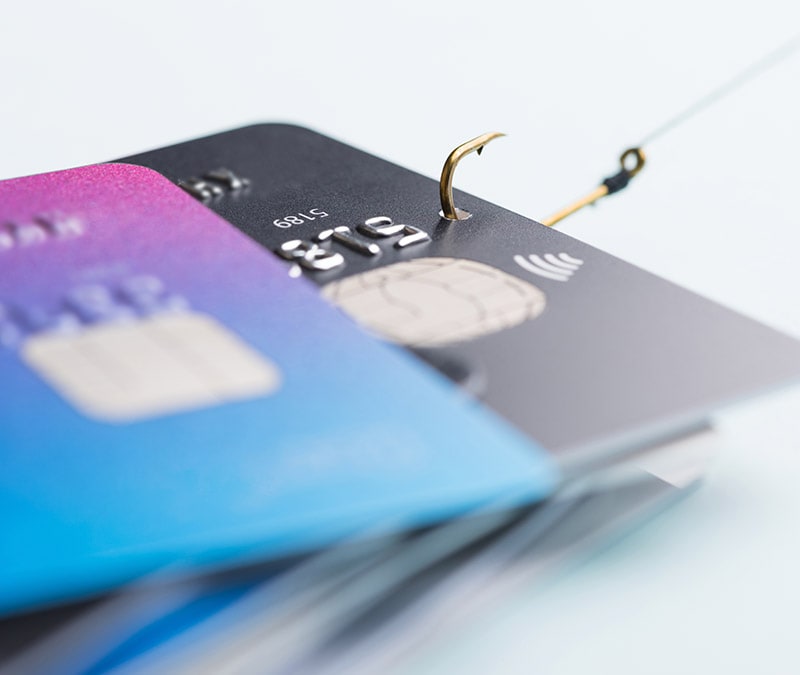
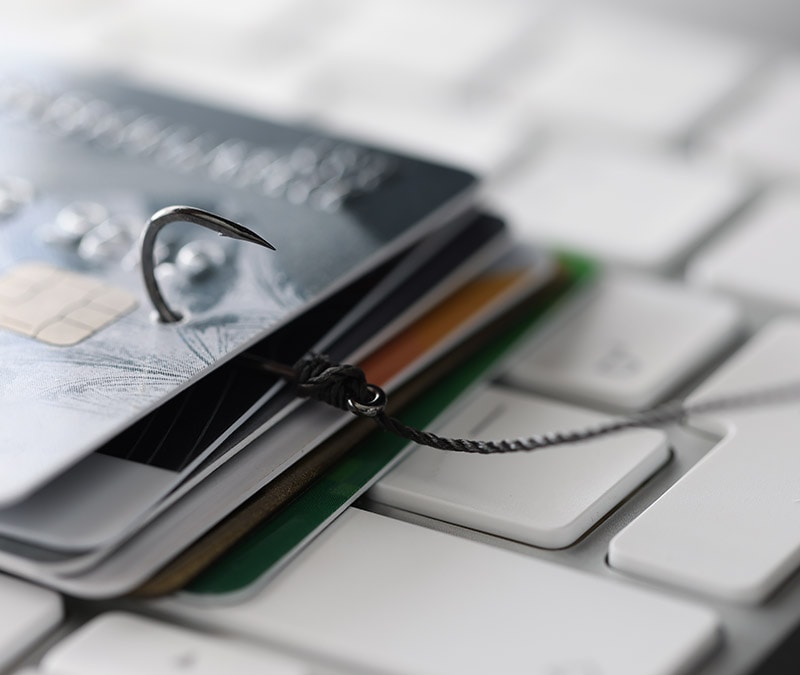



Want more?
Follow us for all the latest news, tips, and updates.